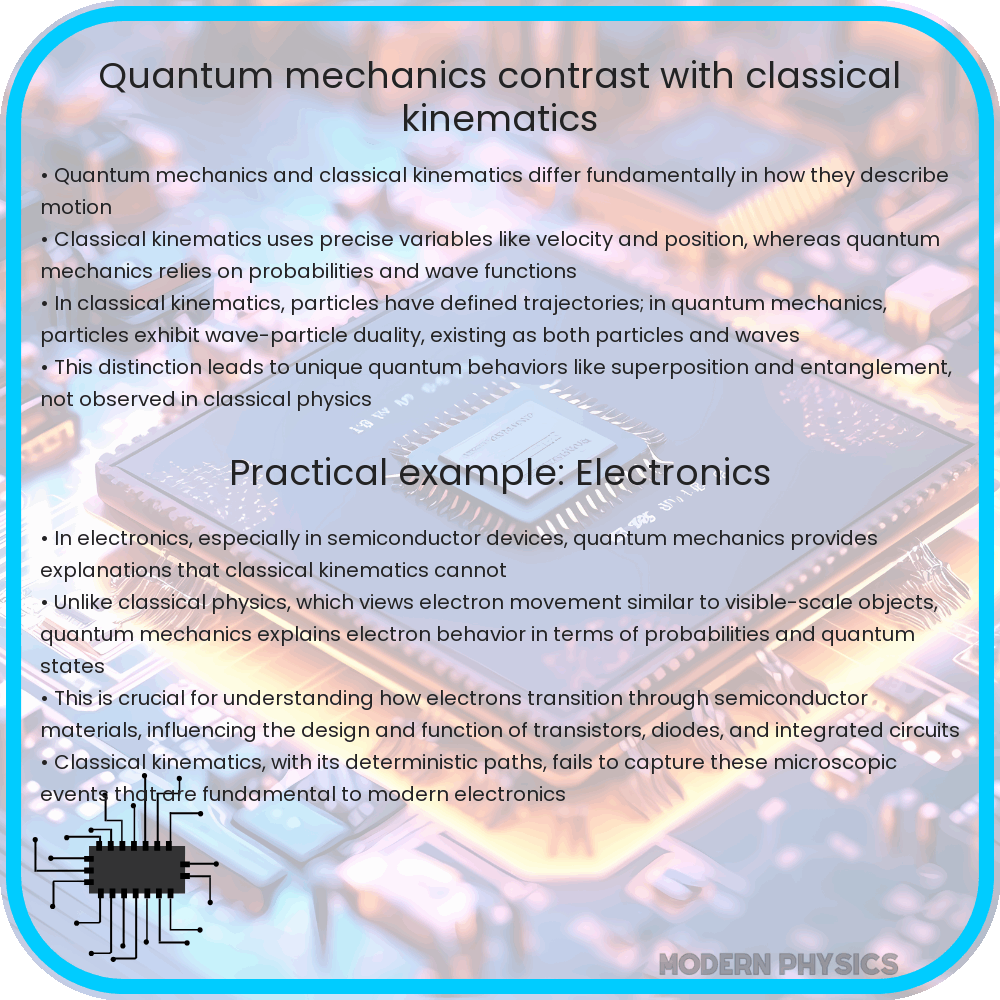Explore the intriguing world of Quantum Mechanics, delving into wave-particle duality, the uncertainty principle, and their groundbreaking applications.

Understanding Quantum Mechanics: Wave-Particle Duality and the Uncertainty Principle
Quantum Mechanics, a fundamental theory in physics, describes the physical properties of nature at the scale of atoms and subatomic particles. Central to quantum mechanics are the concepts of wave-particle duality and the uncertainty principle, which challenge our classical intuitions about the physical world.
Wave-Particle Duality
Wave-particle duality is a core concept in quantum mechanics that posits every particle or quantum entity exhibits both wave and particle properties. This duality was first brought to light in experiments with light and electrons. Light, traditionally considered a wave, was found to exhibit particle-like behavior in certain experiments, like the photoelectric effect, where light knocks out electrons from a material. Conversely, electrons, typically thought of as particles, exhibit wave-like properties, most notably demonstrated in the double-slit experiment. When electrons pass through two close slits, they create an interference pattern typical of waves, not particles.
The Uncertainty Principle
Another cornerstone of quantum mechanics is the uncertainty principle, formulated by Werner Heisenberg. This principle states that the more precisely the position of a particle is determined, the less precisely its momentum can be known, and vice versa. This is not due to limitations in measurement instruments, but rather a fundamental property of quantum systems. The principle is often represented mathematically as \(\Delta x \cdot \Delta p \geq \frac{\hbar}{2}\), where \(\Delta x\) is the uncertainty in position, \(\Delta p\) is the uncertainty in momentum, and \(\hbar\) is the reduced Planck’s constant.
This principle shatters the classical idea that particles have exact, deterministic properties. In quantum mechanics, particles exist in a superposition of states, and their properties are not definite until they are observed. This idea leads to many of the strange and counterintuitive behaviors seen in quantum systems.
Together, wave-particle duality and the uncertainty principle form the bedrock of quantum mechanics, fundamentally altering our understanding of the microscopic world. These concepts have profound implications, not just in physics, but across various scientific fields, influencing everything from chemistry to information technology.
Implications of Quantum Mechanics
Quantum mechanics, with its principles of wave-particle duality and uncertainty, has significant implications in various scientific and technological fields. One of the most notable is the field of quantum computing. In contrast to classical computing, which uses bits that are either 0s or 1s, quantum computing employs quantum bits, or qubits, which can exist in multiple states simultaneously due to superposition. This allows quantum computers to process a vast amount of data at unprecedented speeds, revolutionizing fields like cryptography, materials science, and complex system modeling.
Another area profoundly influenced by quantum mechanics is chemistry, particularly in understanding chemical bonding and reactions. Quantum mechanics explains the behavior of electrons in atoms and molecules, which in turn influences the structure, properties, and reactions of all chemical compounds. This understanding is crucial in developing new materials, drugs, and energy sources.
Quantum Mechanics in Modern Technology
Modern technology has also been deeply impacted by quantum mechanics. Semiconductors, the backbone of modern electronics, operate on principles of quantum mechanics. The development of lasers, which have applications ranging from medicine to communications, is another example of quantum theory in action. Additionally, technologies like MRI (Magnetic Resonance Imaging) in medicine are based on principles of quantum mechanics, revolutionizing diagnostic techniques.
Conclusion
In conclusion, quantum mechanics is not just a theoretical framework for understanding the micro-world. Its principles, especially wave-particle duality and the uncertainty principle, have practical applications that permeate various aspects of modern science and technology. From the development of quantum computers to advancements in medical technology, the influence of quantum mechanics is ubiquitous and profound. It challenges our classical perceptions of reality and continues to inspire innovations and discoveries that shape our world. As we delve deeper into the quantum realm, we may uncover even more mysteries and possibilities that could further transform our understanding of the universe and our place within it.
